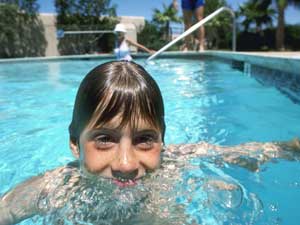 It's called the silent killer. And it can happen in a split second. Were you aware that drowning is the leading cause of death, nationwide, for children under five years of age? Were you aware that Escondido has the second highest number of drowning deaths in the county for children under five years of age?
It's called the silent killer. And it can happen in a split second. Were you aware that drowning is the leading cause of death, nationwide, for children under five years of age? Were you aware that Escondido has the second highest number of drowning deaths in the county for children under five years of age?
The statistics are overwhelming, but what can be done to reduce the number of drowning or near-drowning accidents? PREVENTION.
- Never leave a child or non-swimmer alone in or near a swimming pool, spa, or any other body of water, even for a few moments. This means active attentiveness, especially with small children.
- Children can't be made "water safe." Don't rely on swimming lessons, life preservers or other equipment to protect your child.
- Teach children to enter the water "feet first." Serious injuries may occur when children dive headfirst into shallow water.
- Treat diving boards with respect. Never allow anyone to dive into an above-ground pool. Water depth should always be checked before diving into an in-ground pool.
- Fence in pools and spas from homes and play areas. Fences should be non-climbable with self-latching and self-closing childproof gates.
- Emergency procedures should be clearly written and posted in the pool or spa/hot tub area.
- Keep a cordless phone handy while outside near the pool area.
- Children under the age of 14 should not be left unsupervised in the pool area.
- Don't rely on solar pool blankets to keep children from falling into the pool. Children can easily fall into the pool and slip under the blanket, making it difficult for them to break the surface or be spotted once submersed.
- Look in the water first if a child is missing.
- Never leave toys in the pool or spa area.
- Poolside equipment, including a ring buoy with an attached line and/or a long-handled hook, should be available to assist in removing a victim from the water. This equipment should never be used for play.
- Obtain training in CPR and insist anyone watching your child also be trained. Survival depends on rescuing the child quickly and restarting the breathing process, even while the child is still in the water.
- CALL 9-1-1 in case of emergency. Give your name, location, phone number, what the emergency is, the condition of the victim(s), and what emergency procedures are in progress. If the victim is breathing, keep them calm and wait for emergency assistance. If the victim is not breathing, initiate CPR. If you don't know CPR, ask the emergency dispatcher for assistance.